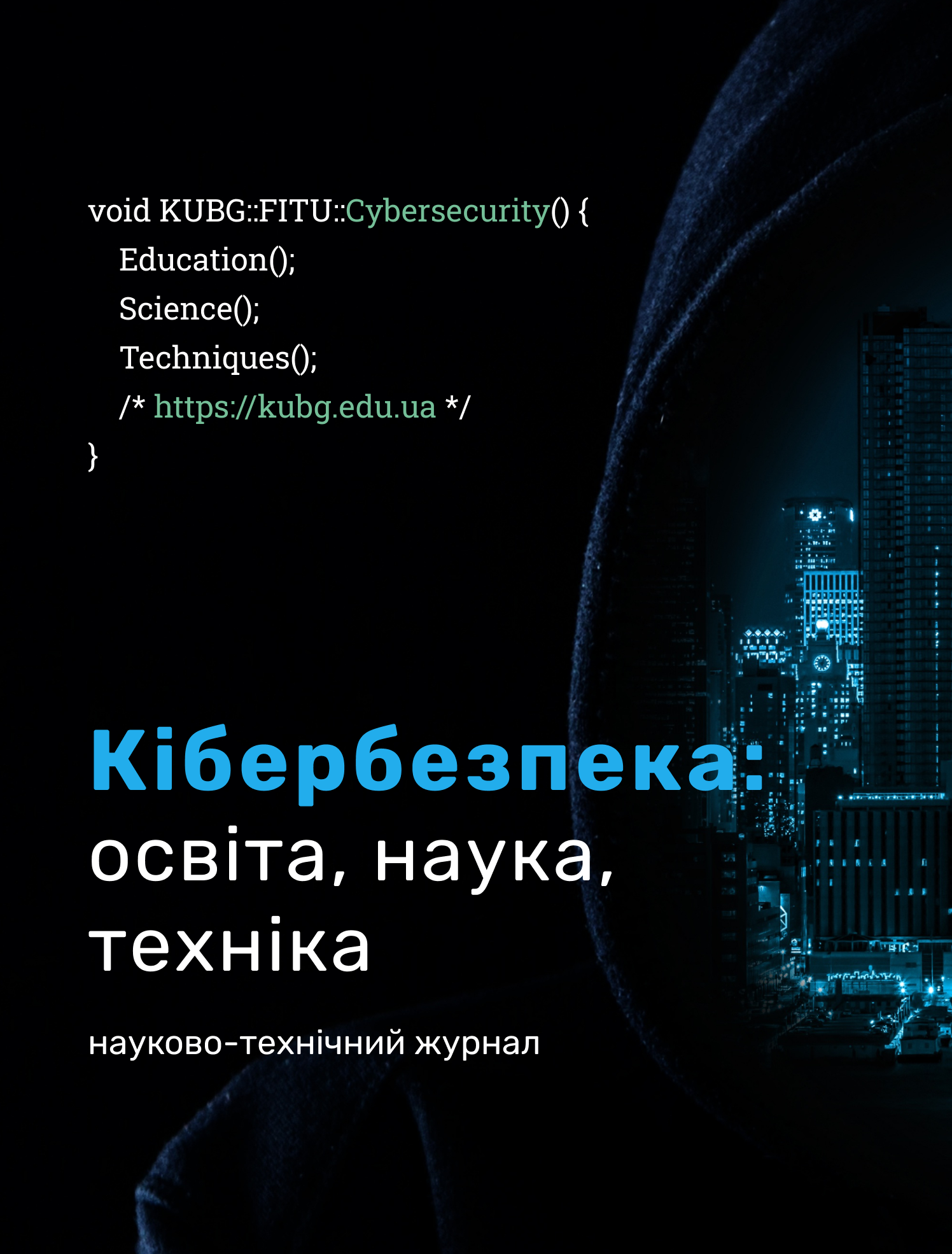МЕТОД ВИЯВЛЕННЯ ВИТОКУ ІНФОРМАЦІЇ ЗА ВІДХИЛЕННЯМ ТРАФІКУ З ІНФОРМАЦІЙНОЇ МЕРЕЖІ ЗВ’ЯЗКУ
DOI:
https://doi.org/10.28925/2663-4023.2024.23.182198Ключові слова:
відхилення трафіку, метод, модель, прогнозування, інформаційні технології, стійкість, запізнення, конфіденційність, доступність, неправдива інформація, персональні даніАнотація
У роботі проведено аналіз методів виявлення витоку мовної інформації Проведений аналіз показав відсутність єдиного науково методичного апарату або автоматизованих програмних комплексів для забезпечення оперативного здійснення аналізу трафіку. Тому робота присвячена актуальної тематиці виявлення витоку інформації за відхиленням трафіку з інформаційної мережі зв’язку.
Пропонується удосконалений метод забезпечення оперативного здійснення аналізу трафіку та інформування про підозрілу ситуацію. Ситуацію яка потребуює подальшого детального аналізу трафіку автоматизованими програмними комплексами або відповідними спеціалістами.
Розроблений метод дозволяє здійснювати інформування, у реальному часі, відповідальних спеціалістів, про можливий виток інформації, якій базується на аналізі відхилення характеру трафіку з елементів інформаційної мовної мережі. Відхилення, характеру трафіку з елементів параметрів мережі вимірюються відносно звичного трафіку телефонної або мовної мережі відносно цих параметрів. Проводиться порівняльний аналіз звичайного трафіка з трафіком у реальному часі.
Наведений метод додатково удосконалює методику. Удосконалення проведено за рахунок використання практичних рекомендації щодо сталих коефіцієнтів, розрахунків. Ці коефіцієнти для удосконаленого методу обирались розрахунковим та емпіричним шляхом, що дозволяє значно скоротити реакцію системи оцінки трафіку, системи яка використовує розроблену методику для виявлення можливого витоку мовної інформації.
Завантаження
Посилання
Atassi, A., & Khalil, H. (1999). A separation princi ple for the stabilization of class of nonlinear systems. IEEE Trans. Automat. Control. 44(9), 1672–1687.
Tao, G., & Ioannou, P. (1993). Model reference adaptive control for plants with unknown relative degree. IEEE Trans. Automat. Control. 38(6), 976–982.
Laptev, O. (2019). Comparative analysis of methods of recognition of signals of radio equipment based on frequency transformations. Telecommunications and information technologies: a scientific journal, 3, 71–83.
Laptev, O., et al. (2019). Multi-agent technology for finding digital radio beacons based on bee colony clustering. Journal of Information Protection, 21(3), 194–202.
Laptеv, A., et al. (2019). The method of searching for digital means of illegal reception of information in information systems in the working range of Wi-Fi. International Journal of Advanced Research in Science, Engineering and Technology, 6(7), 10101–10105.
Laptіev, O., et al. (2019). Mathematical model of the information network structure based on non-stationary hierarchical and stationary hypernet. Collection of scientific works of the Military Institute of Taras Shevchenko Kyiv National University, 64, 124–132.
Kapustian, O., et al. (2022). Approximate Optimal Control for a Parabolic System with Perturbations in the Coefficients on the Half-Axis. Axioms, 11(4), 175. https://doi.org/10.3390/axioms11040175
Korchenko, A.O., et al. (2021). Development of a method for construction of linguistic standards for multicriterial evaluation of honeypot efficiency. Eastern-European journal of enterprise technologies, 1(2) (109), 14–23. https://doi.org/10.15587/1729-4061.2021.225346
Svynchuk, O. Et al. (2021). Image compression using fractal functions. Fractal and Fractional, 5(2), 1–14. https://doi.org/10.3390/fractalfract5020031
Laptiev, O., et al. Method of Detecting Radio Signals using Means of Covert by Obtaining Information on the basis of Random Signals Model. International Journal of Communication Networks and Information Security (IJCNIS), 13(1), 48–54.
Laptiev, O., et al. (2021). Method of Determining Trust and Protection of Personal Data in Social Networks. International Journal of Communication Networks and Information Security (IJCNIS), 13(1), 15–21.
Laptiev, O., et al. (2021). Improved model of estimating economic expenditures on the information protection system in social networks. Electronic Professional Scientific Edition “Cybersecurity: Education, Science, Technique”, 4(12), 19–28. https://doi.org/10.28925/2663-4023.2021.12.1928
Laptiev, O., et al. (2022). Method of Detecting Radio Signals using Means of Covert by Obtaining Information on the basis of Random Signals Model. International Journal of Communication Networks and Information Security (IJCNIS), 13(1). https://doi.org/10.17762/ijcnis.v13i1.4902
Barabash, O., et al. (2021). Comprehensive Methods of Evaluation of Distance Learning System Functioning. International Journal of Computer Network and Information Security (IJCNIS), 13(3), 62–71. https://doi.org/10.5815/ijcnis.2021.03.06
Laptiev, O., et al. (2022). The method of spectral analysis of the determination of random digital signals. International Journal of Communication Networks and Information Security (IJCNIS), 13(2). https://doi.org/10.17762/ijcnis.v13i2.5008
Laptievа, T. (2021). Algorithm for determining the measure of existence of unreliable information in the conditions of information conflict. Electronic Professional Scientific Edition “Cybersecurity: Education, Science, Technique”, 2(14), 15–25. https://doi.org/10.28925/2663-4023.2021.14.1525
Nakonechnyi, V., et al. (2022). Improving the method of detecting and clustering sources of false information. Scientific technologies, 54(4), 105–111. https://doi.org/10.18372/2310-5461.54.16747
Laptіeva, T., Lukova-Chuiko, N. (2022). Improvement of the method of detection of false information based on the method of expert evaluation “Delphi”. Scientific technologies, 55(3), 193–199. https://doi.org/10.18372/2310-5461.55.16901
Zamrii, I., et al. (2022). Algorithm of control and prediction of functional stability of complex information and technical systems. Telecommunications and information technologies, 1(74), 4–15.
Laptiev, S. (2022). An improved method of protecting personal data from attacks using social engineering algorithms. Electronic specialized scientific publication “Cybersecurity: education, science, technology”, 4(16), 45–62. https://doi.org/10.28925/2663-4023.2022.16.4562
Laptiev, S., & Tolupa, S. (2022). The methodology for evaluating the functional stability of the protection system of special networks. Information technologies, cyber security, 55(3), 178–183. https://doi.org/10.18372/2310-5461.55.16900
Korolkov, R., & Laptіev, S. (2022). Realistic simulation of a “war driving” attack on a wireless network. Electronic specialized scientific publication “Cybersecurity: education, science, technology”, 2(18), 99–107. https://doi.org/10.28925/2663-4023.2022.18.99107
Опубліковано
Як цитувати
Номер
Розділ
Ліцензія
Авторське право (c) 2024 Сергій Глухов; Андрій Собчук, Володимир Ровда, Микола Половінкін, Віталій Пономаренко

Ця робота ліцензується відповідно до Creative Commons Attribution-NonCommercial-ShareAlike 4.0 International License.




